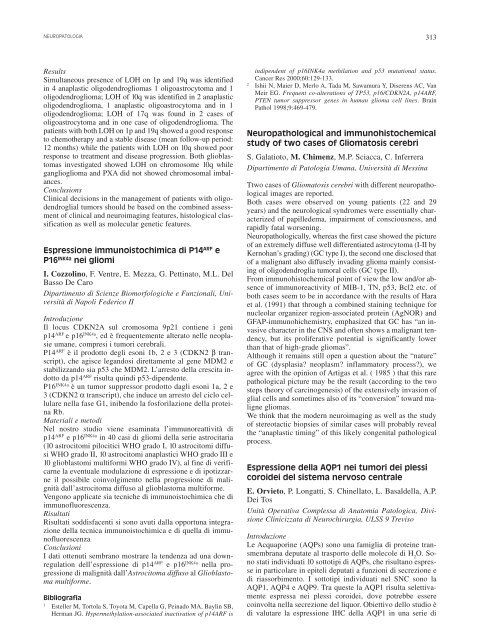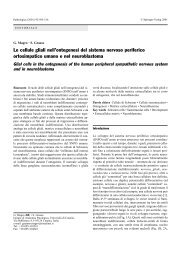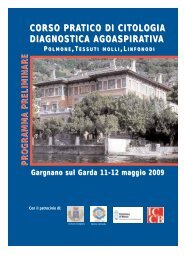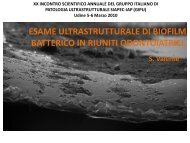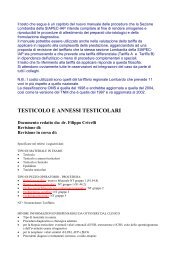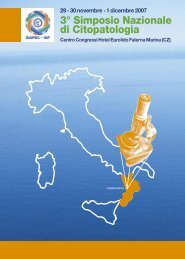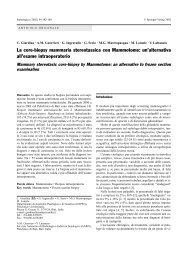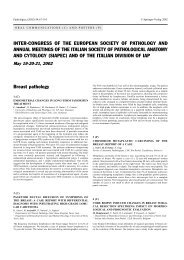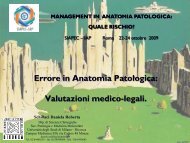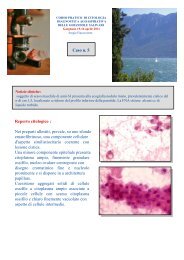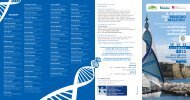You also want an ePaper? Increase the reach of your titles
YUMPU automatically turns print PDFs into web optimized ePapers that Google loves.
NEUROPATOLOGIA313ResultsSimultaneous presence of LOH on 1p and 19q was identifiedin 4 anaplastic oligodendrogliomas 1 oligoastrocytoma and 1oligodendroglioma; LOH of 10q was identified in 2 anaplasticoligodendroglioma, 1 anaplastic oligoastrocytoma and in 1oligodendroglioma; LOH of 17q was found in 2 cases ofoligoastrocytoma and in one case of oligodendroglioma. Thepatients with both LOH on 1p and 19q showed a good responseto chemotherapy and a stable disease (mean follow-up period:12 months) while the patients with LOH on 10q showed poorresponse to treatment and disease progression. Both glioblastomasinvestigated showed LOH on chromosome 10q whileganglioglioma and PXA did not showed chromosomal imbalances.ConclusionsClinical decisions in the management of patients with oligodendroglialtumors should be based on the combined assessmentof clinical and neuroimaging features, histological classificationas well as molecular genetic features.Espressione immunoistochimica di P14 ARF eP16 INK4a nei gliomiI. Cozzolino, F. Ventre, E. Mezza, G. Pettinato, M.L. DelBasso De CaroDipartimento di Scienze Biomorfologiche e Funzionali, Universitàdi Napoli Federico IIIntroduzioneIl locus CDKN2A sul cromosoma 9p21 contiene i genip14 ARF e p16 INK4a , ed è frequentemente alterato nelle neoplasieumane, compresi i tumori cerebrali.P14 ARF è il prodotto degli esoni 1b, 2 e 3 (CDKN2 β transcript),che agisce legandosi direttamente al gene MDM2 estabilizzando sia p53 che MDM2. L’arresto della crescita indottoda p14 ARF risulta quindi p53-dipendente.P16 INK4a è un tumor suppressor prodotto dagli esoni 1a, 2 e3 (CDKN2 α transcript), che induce un arresto del ciclo cellularenella fase G1, inibendo la fosforilazione della proteinaRb.Materiali e metodiNel nostro studio viene esaminata l’immunoreattività dip14 ARF e p16 INK4a in 40 casi di gliomi della serie astrocitaria(10 astrocitomi pilocitici WHO grado I, 10 astrocitomi diffusiWHO grado II, 10 astrocitomi anaplastici WHO grado III e10 glioblastomi multiformi WHO grado IV), al fine di verificarnela eventuale modulazione di espressione e di ipotizzarneil possibile coinvolgimento nella progressione di malignitàdall’astrocitoma diffuso al glioblastoma multiforme.Vengono applicate sia tecniche di immunoistochimica che diimmunofluorescenza.RisultatiRisultati soddisfacenti si sono avuti dalla opportuna integrazionedella tecnica immunoistochimica e di quella di immunofluorescenzaConclusioniI dati ottenuti sembrano mostrare la tendenza ad una downregulationdell’espressione di p14 ARF e p16 INK4a nella progressionedi malignità dall’Astrocitoma diffuso al Glioblastomamultiforme.Bibliografia1Esteller M, Tortola S, Toyota M, Capella G, Peinado MA, Baylin SB,Herman JG. Hypermethylation-associated inactivation of p14ARF isindipendent of p16INK4a methilation and p53 mutational status.Cancer Res 2000;60:129-133.2Ishii N, Maier D, Merlo A, Tada M, Sawamura Y, Diserens AC, VanMeir EG. Frequent co-alterations of TP53, p16/CDKN2A, p14ARF,PTEN tumor suppressor genes in human glioma cell lines. BrainPathol 1998;9:469-479.Neuropathological and immunohistochemicalstudy of two cases of Gliomatosis cerebriS. Galatioto, M. Chimenz, M.P. Sciacca, C. InferreraDipartimento di Patologia Umana, Università di MessinaTtwo cases of Gliomatosis cerebri with different neuropathologicalimages are reported.Both cases were observed on young patients (22 and 29years) and the neurological syndromes were essentially characterizedof papilledema, impairment of consciousness, andrapidly fatal worsening.Neuropathologically, whereas the first case showed the pictureof an extremely diffuse well differentiated astrocytoma (I-II byKernohan’s grading) (GC type I), the second one disclosed thatof a malignant also diffusely invading glioma mainly consistingof oligodendroglia tumoral cells (GC type II).From immunohistochemical point of view the low and/or absenceof immunoreactivity of MIB-1, TN, p53, Bcl2 etc. ofboth cases seem to be in accordance with the results of Haraet al. (1991) that through a combined staining technique fornucleolar organizer region-associated protein (AgNOR) andGFAP-immunohichemistry, emphasized that GC has “an invasivecharacter in the CNS and often shows a malignant tendency,but its proliferative potential is significantly lowerthan that of high-grade gliomas”.Although it remains still open a question about the “nature”of GC (dysplasia? neoplasm? inflammatory process?), weagree with the opinion of Artigas et al. ( 1985 ) that this rarepathological picture may be the result (according to the twosteps theory of carcinogenesis) of the extensively invasion ofglial cells and sometimes also of its “conversion” toward malignegliomas.We think that the modern neuroimaging as well as the studyof stereotactic biopsies of similar cases will probably revealthe “anaplastic timing” of this likely congenital pathologicalprocess.Espressione della AQP1 nei tumori dei plessicoroidei del sistema nervoso centraleE. Orvieto, P. Longatti, S. Chinellato, L. Basaldella, A.P.Dei TosUnità Operativa Complessa di Anatomia Patologica, DivisioneClinicizzata di Neurochirurgia, ULSS 9 TrevisoIntroduzioneLe Acquaporine (AQPs) sono una famiglia di proteine transmembranadeputate al trasporto delle molecole di H 2O. Sonostati individuati 10 sottotipi di AQPs, che risultano espressein particolare in epiteli deputati a funzioni di secrezione edi riassorbimento. I sottotipi individuati nel SNC sono laAQP1, AQP4 e AQP9. Tra queste la AQP1 risulta selettivamenteespressa nei plessi coroidei, dove potrebbe esserecoinvolta nella secrezione del liquor. Obiettivo dello studio èdi valutare la espressione IHC della AQP1 in una serie di


